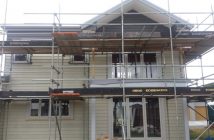Or can it be more, a creative reflection of who we are?
I was led to ponder this question by a comment made recently by Brad Olsen, principal economist and director of Infometrics, as part of a presentation to the Waipa District Council. In response to a question about the performance of NZ’s economy, Brad discussed our nation’s productivity record and went on to say “Why does every New Zealander need a completely bespoke home that’s different – in every way, shape and form – from any other home built before?”
This could easily be seen as an economist’s utilitarian view of houses as nothing more than accommodation, or a market view of housing as a product to be consumed. While Olsen’s point was possibly more subtle than that, it triggered in me a strong negative response with a visualisation of neighbourhoods of identical boxes.
In fact it reminded me of the Pete Seeger hit “Little Boxes on the Hillside” written by Malvina Reynolds when I was three or four. In the ‘60s it was a somewhat of an anthem against sameness and homogeneity, and probably one of many influences that inspired me into placemaking and architecture.
I view that all people want to create in some way; whether in a men’s shed environment, an art studio, sewing, crocheting, gardening, building a model railway, or creating and nurturing a child, a family, or a business, as examples.
A concept that really resonates with me is Maslow’s hierarchy of needs. This suggests that we aren’t motivated to pursue self-fulfilment needs like creative pursuits until we’ve first met our basic needs for things like food and shelter. It’s easy to interpret this as defining those hierarchical needs as mutually exclusive or separate, and tempting in that light to think of housing as merely a way to meet the basic need for shelter and safety.
However, surely a simple expression of being human is the achievement of multiple needs through a single endeavour. Indeed, this is the case in our choice of shelter. Given the opportunity, we all gain satisfaction from creating environments and places that express something of ourselves. That might be customising a new build, renovating our existing home, or working with an architect to create a truly purposeful home and environment that reflects our personality and values. I certainly view this creative home-making as one of the appeals that some people have for working with the Tiny House opportunity.
And yet, creativity and creative fulfilment are given little thought in most new housing development. Housing companies are focused on minimising cost to make a profit, while government organisations like Kāinga Ora are looking to higher density as a remedy to both cost and insufficient housing stock. It is an easy mistake to equate ‘cheap’ with ‘affordable’.
There is a risk that we start to view density as a silver bullet that might somehow enable the building of more houses as well as keeping costs down and minimising sprawl. I fear that such an expectation may simply lead to lower quality developments and poor social outcomes as seen with tenement housing in the UK in the mid twentieth century.
Of course, medium or high density and multiple housing can be done well; the Crescent in Bath is a good example, many terraced homes in Britain, and even projects in New Zealand such as Hamilton’s Hayes Paddock. But they do require architectural and community intent, and the pursuit of quality is not easily reconciled with cost-saving goals.
Another solution for NZ might seek to harness the positivity and hope of creativity and personal expression to create better houses and better communities. Elements of owner-built or community-built housing – including papakāinga – can be incorporated into architectural concepts for new development, making residents and communities participants in the process, rather than simply passive consumers of the result.
Some examples of this exist, such as the Tondo community in the Philippines, an international design competition that architect Ian Athfield won in 1976. The concept, for housing in the squatter settlement of Manila, built on the strong sense of enabling communities, and utilised self-built housing made with locally available materials and construction methods.
For emergency or state housing, in often-vulnerable communities, this might prove especially powerful, providing much needed shelter while also engaging residents and building community spirit and resilience.
Ultimately, the construction industry should be concerned with addressing the shortage of housing in a way that provides quality accommodation and environments for kiwi now and in the future. Done well, housing might also grant its inhabitants the elevating joy of creative endeavour. Quality housing that enriches communities and stands the test of time is, in reality, the only truly affordable housing for the long term.





